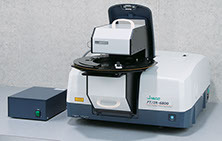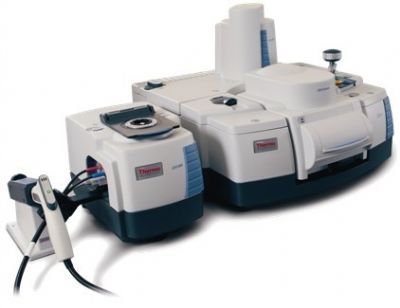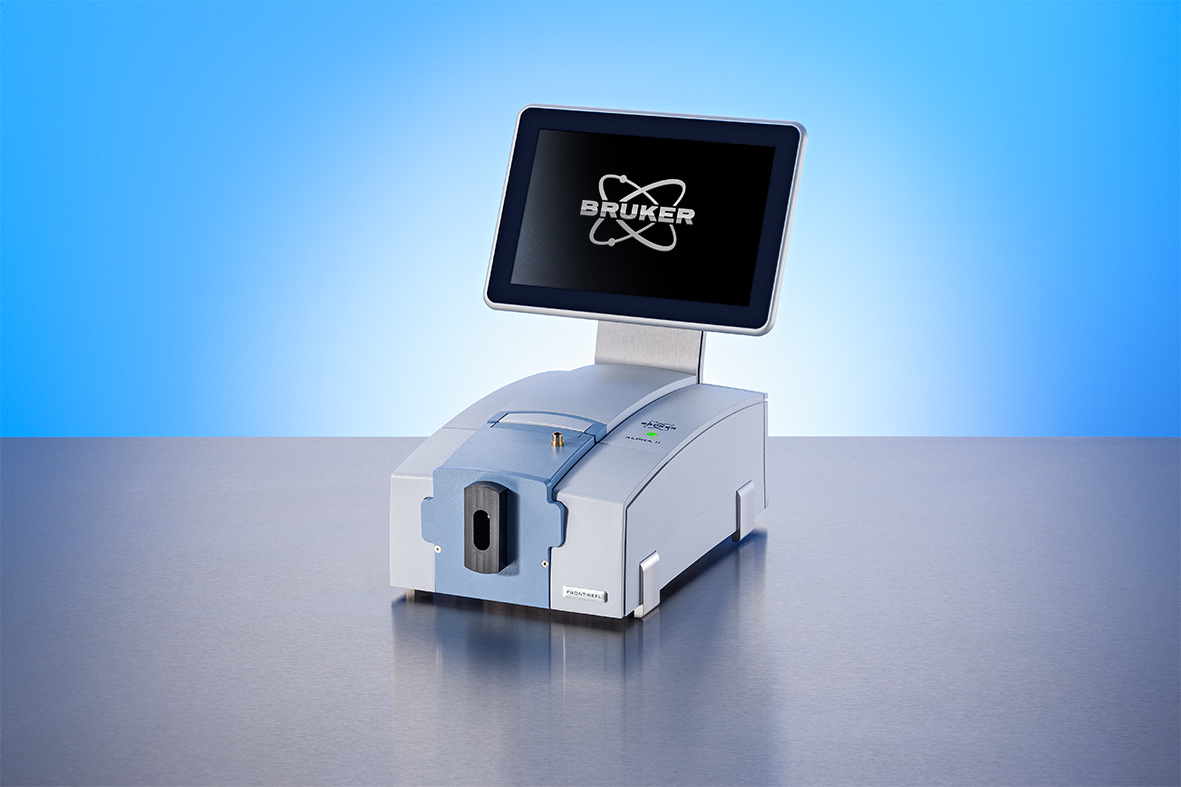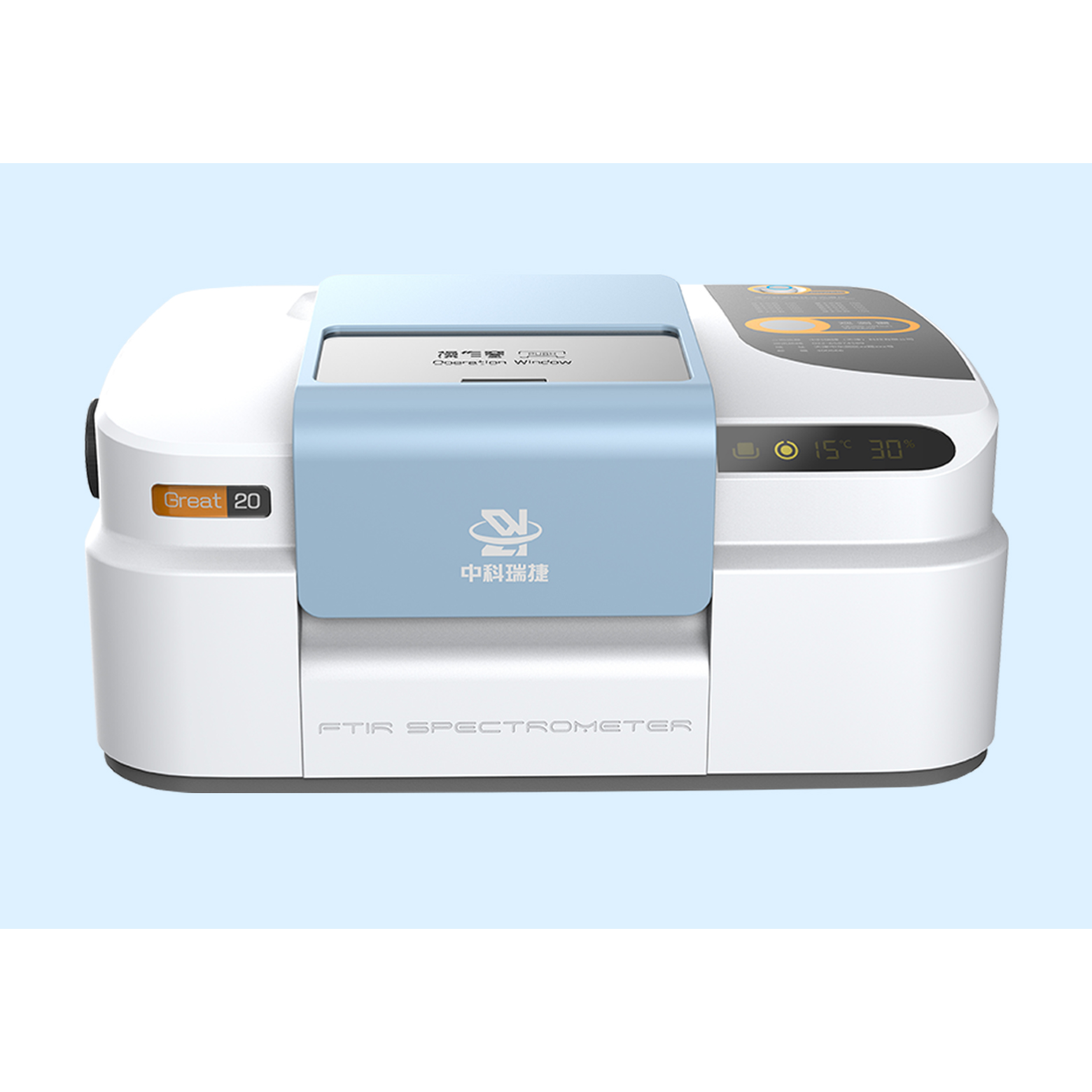为了验证各种水电解质溶液中水化和离子之间的关系,我们使用JASCO FT/IR- 6300FV和液体三反射ATR附件对纯水和各种盐水溶液进行了远红外ATR测量。
方案详情

为了验证各种水电解质溶液中水化和离子之间的关系,我们使用JASCO FT/IR- 6300FV和液体三反射ATR附件对纯水和各种盐水溶液进行了远红外ATR测量。这些测量结果的结果概述如下。在中红外和远红外区域对纯水进行了ATR测量。对测量的光谱应用ATR修正得到的结果如图2所示。测量条件见表1。如表1所示,FT/IR-6000系列允许根据测量频率改变光源和分束器,从而能够在广泛的光谱范围内进行测量。图2显示了一个在600 cm-1附近的峰,这可能是由于水的分子间运动而产生的吸收。在180cm-1(图2中黄色边界)附近观察到另一个峰,这被认为为氢键。同时,还测量了溶质类型在180 cm-1附近的峰的行为变化。Application Note Characterized by wavelengths longer than the mid-infrared region, the far-infrared region is also referred to as the terahertz region. In recent years, this region has been used to evaluate crystal polymorphs for pharmaceuticals and semiconductor device e materials,as well 1as for archaeological research applications, including the study of inorganicpigments .I Light in n the far-infrareddregion (terahertz waves) corresponds to hydrogen bonding and Van der Waals forces believed to hold the key to an understanding of the functional expressions of and structural changes in biological molecules in liquids, as well as absorption 6energy in hydrophobic interactions.Calculations, generally theoretical, have been applied for such purposes in the past, but using light in the far-infrared regionshould allowt the acquisitionof important experimental i nformation regarding such behavior. Figure 1: ATR-500/Mi+ATR crystal plate (Upper right: Prism and liquid cell) The t ransmission method i s commonly used for measurements i n the far-infrared region but is not suitable for measurements of samples with significant absorption in the far-infrared region. For measurements of liquid samples such as biological molecules in an aqueous solution, cell thickness must be reduced to about 10 um or less to avoid the effects of solvent absorption. This makes i t difficult to directly measure gel-state materials or biological samples, like protein solutions. ATR measurements utilize infrared light focused into a crystalline prism which penetrates slightly into the sample when the sample and the prism are in intimate contact. The method allows easy measurements of samples with good contact characteristics, such as l iquids and gel-state materials, simply by placing the sample on the prism. Although the effects of moisture vapor are more pronounced i n the far-infrared region than in the mid-infrared region, maintaining the interferometer and sample chamber in a vacuum during measurements reduces the effects of the water bands, but depressurizing the sample chamber to a vacuum causes l iquid samples to vaporize, preventing ATR sample measurements of the sample. The liquid triple-reflection ATR crystal plate for the THz (far-infrared) region that can be mounted on the ATR-500/Mi, used for these measurements, is configured to allow sealing of the ATR crystal area. This keeps the liquid from vaporizing when the sample chamber is depressurized and enables simple ATR measurements. The Si prism in the ATR accessory can provide a penetration depth of approximately 2 um at 1000 cm and approximately 10 um at 200 cm-. To verify the relationship between hydration and ions in various aqueous electrolyte solutions, Far-IR ATR measurements of pure water and various salt water solutions were performed using the JASCO FT/IR-6300FV, and a liquid triple-reflection ATR accessory. The results of these measurements are outlined below. 2. Measurement Conditions System: FT/IR-6300FV Measurement Method: ATR method (Triple-reflection)Resolution: 2 cm1 Accumulations: 128Accessory: ATR-500/Mi + liquid triple-reflection ATR crystal plate (for Far-IR) Sample: pure water, 2 or 5 mol/L-Sodium chloride and Potassium chloride solution, 2 mol/L-Calcium chloride solution 140-AT-0221 3. Results and discussions ATR measurements were performed of pure water in the mid-infrared and far-infrared regions. The results obtained by applying ATR corrections to the measured spectra are shown in Figure 2. The measurement conditions are given in Table 1. AAsS sShown in Table 1, the FT/IR-6000 series allows changes in the light source and beam splitter based on measurement frequency, enabling measurements across a broad spectral range. A peak near 600 cmpotentially assigned to the absorption resulting from the i ntermolecular motion of water is shown in Figure 2. Another peak was observed near 180 cm (vellow border in Figure 2). which is assigned to hydrogen bonding. The change in the behavior of the peak near 180 cm resulting from the solute type was also measured . Table 1 Measurement Condi t ions for Mid-IR and Far-IR region Wavenumber「cm-11 Beam splitter Light source Detector 4000-400*1(Green-lined) Ge/KBr High-intensityceramic source DLATGS(standard) 450-100*2(Blue-lined) 5 pm Mylar High-intensityceramic source Si bolometer(option) 110-20(Red-lined) 25 pm Mylar water-cooledmercury lightsource *1 The ATR PRO470-H (diamond prism) was used under normal atmospheric conditions. *2 The S/N ratio i s lower in the frequency range of 150 cm- and below. The stack graph (Figure 3) shows the ATR spectra of these aqueous solutions near 180 cm. Table 2 and Fig. 3indicate the positions of the peaks assigned to hydrogen bonding. In all cases, the monovalent cation shi f ts toward the low frequency side compared to water, indicating a correlation between density and shift width. In the Potassium solution (Kt) the large ion radius shifts the peaksignificantly toward the low frequency side, as compared to the Sodium solution (Nat). In an aqueous solution containing Calc i um (Ca”+), a bivalent cation, the peak shifts toward the high frequency side compared to water alone, behavior opposite that of the monovalent cation. This suggests that the ion radius, the electrical charge, and the water solution activity affect the hydrogen bonding energy. As described above, using a liquid ATR accessory for measurements of solutions in a vacuum in the far-infrared region was confirmed to be highly effective in detecting slight changes in the behavior of aqueous solutions. Since significant differences between Nat and K+ were verified in the measurements, we believe the l iquid ATR accessory designed for the Far-IR region should find applications not just in the analysis of hydrogen bonding and intermolecular forces, but also the functions of and structural changes in molecules in solution., but f for elucidating phenomena within biological organisms. Figure 2: ATR spectra of pure water (Upper right: Enlargement below 1000 cm-) Table 2 Peak Shift of Each Sample Sample(Valence) Ion radius[nm] Conc.[mol/L1 Peak top「cm-1 Peak shift「cm-1 H2O -一 一 182.2 一 CaCl2aq (+2) 0.114 2.0 187.1 +4.9 NaClaq (+1) 0.116 2.0 181.3 -0.9 5.0 177.4 -4.8 KClaq (+1) 0.152 2.0 177.4 -4.8 5.0 164.9 -17.3 Figure 3: ATR spectra of Each Sample Portable Synchrotron Light Sources and Advanced Applications, 2007,73-76. T el :+81-42-666-1322.Fax:+81-42-665-6512
确定
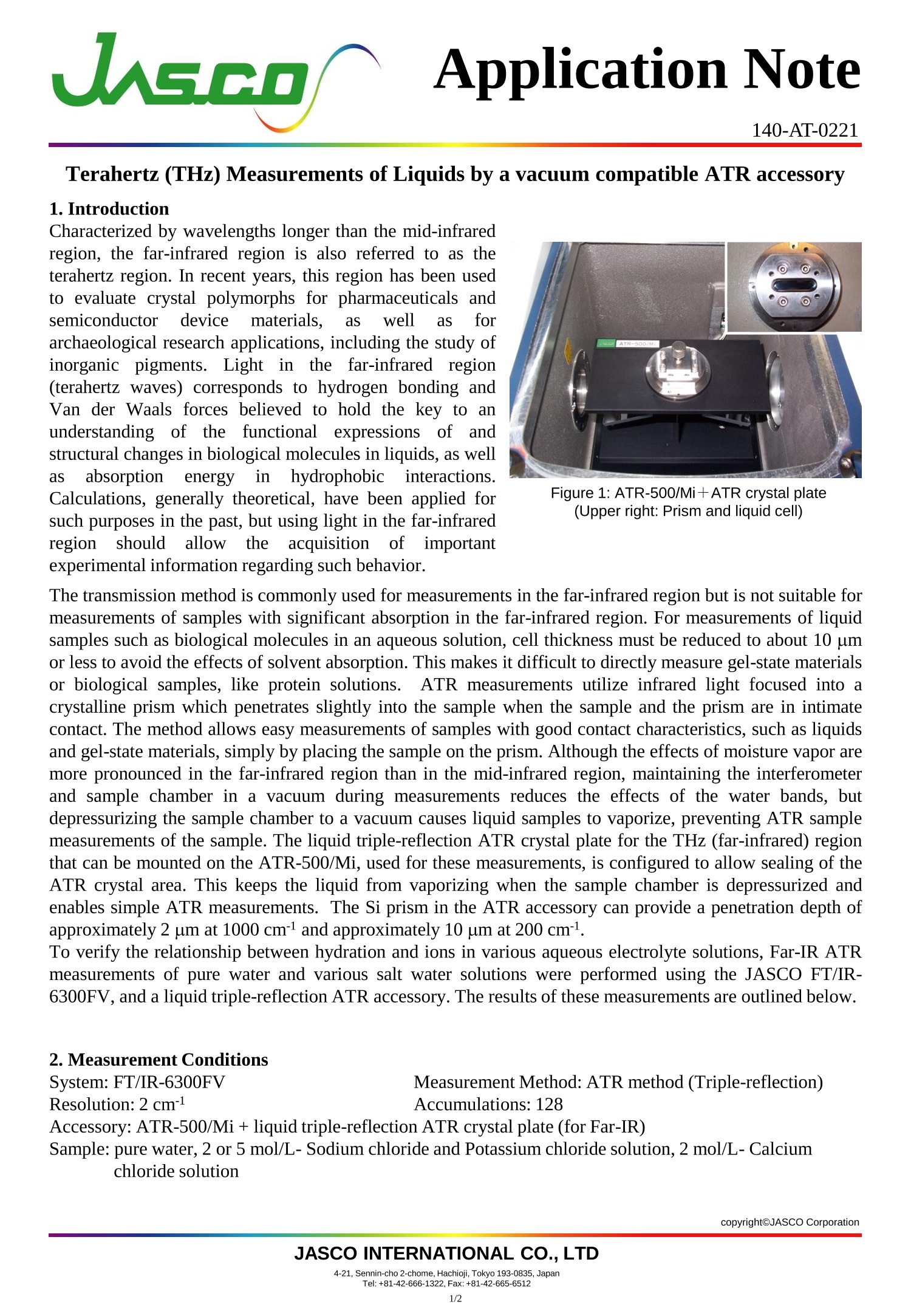
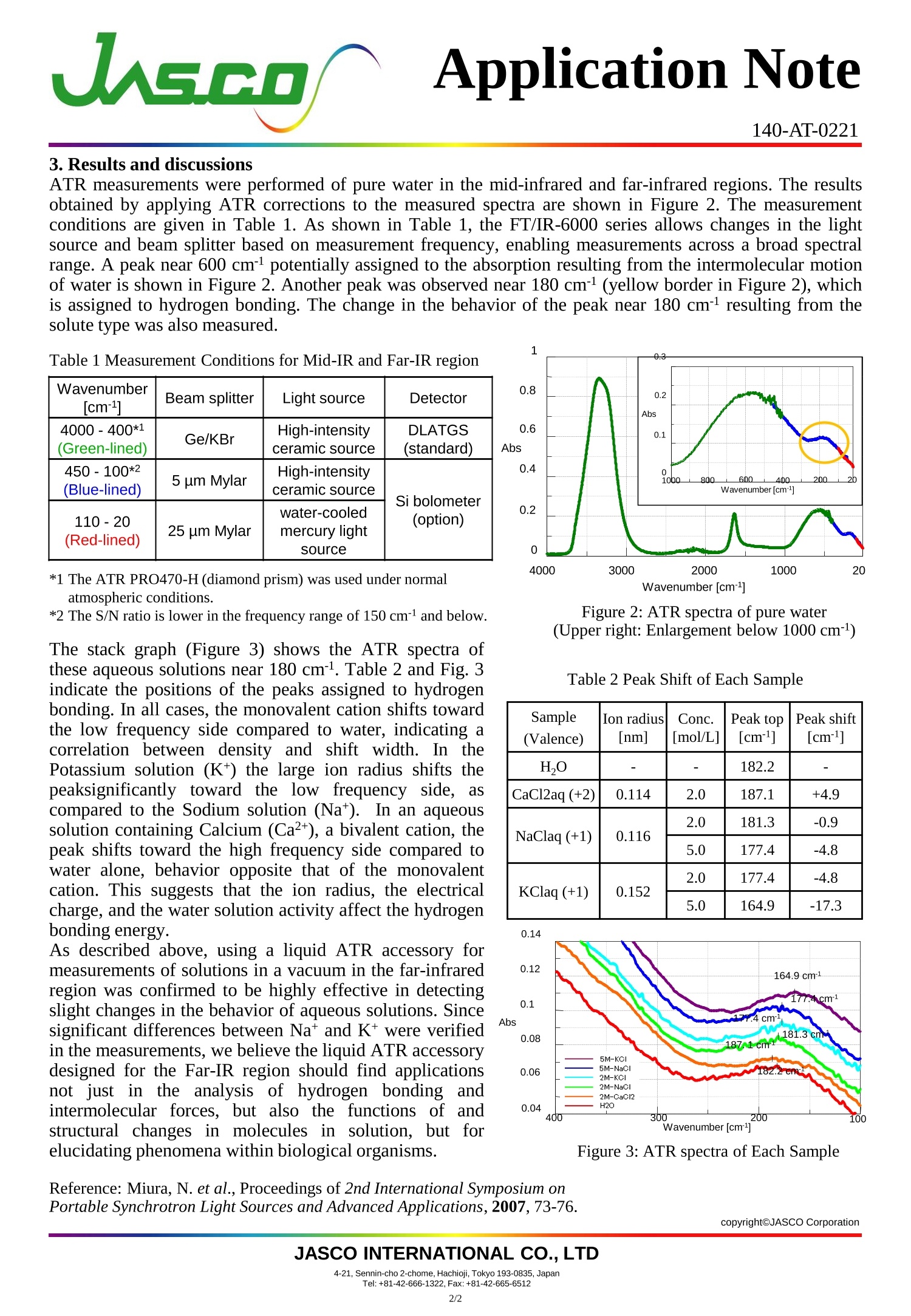
还剩1页未读,是否继续阅读?
佳士科商贸有限公司为您提供《用真空FTIR测量液体的太赫兹ATR》,该方案主要用于其他中远红外ATR测量检测,参考标准--,《用真空FTIR测量液体的太赫兹ATR》用到的仪器有JASCO傅立叶变换红外光谱仪FT/IR-6000
推荐专场
相关方案
更多

